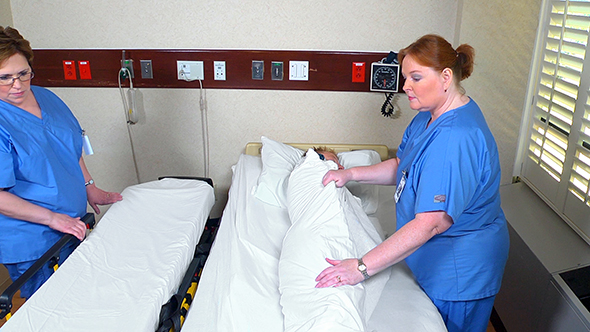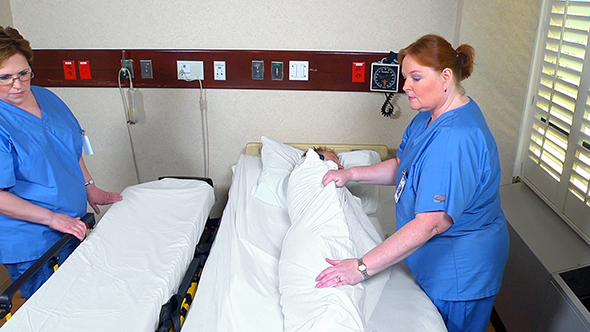Body Mechanics and Exercise
Select a Skill:
- » Moving the Person Up in Bed
- » Positioning the Person in Bed
- » Transferring the Person to a Chair or Wheelchair
- » Moving the Person to a Stretcher
- » Transferring the Person Using a Mechanical Lift
- » Assisting with Range-of-Motion Exercises
- » Helping the Person Walk
Take the Review Test:

Purpose

- Stretchers (gurneys) are used to transport persons to other areas. They are used for persons who cannot sit up, must stay in a lying position, or are seriously ill.
- A folded flat sheet or bath blanket covers the stretcher. A pillow and extra blankets are on hand.
- An assist device is used for the transfer. At least two or three staff members are needed for a safe transfer. OSHA recommends the following:
- If the person weighs less than 100 pounds, use a lateral sliding aid and two staff members.
- If the person weighs 100 to 200 pounds, use a lateral sliding aid or a friction-reducing device and two staff members.
- If the person weighs more than 200 pounds, use one of these:
- A lateral sliding aid and three staff members
- A friction-reducing device or lateral transfer device and two staff members
- A mechanical lateral transfer device with a built-in slide board and three staff members.
Equipment
Roll cursor over items to see labels. For the purposes of clearly depicting the equipment, a barrier is not shown in this photo. When providing care, a barrier should always be placed on the surface before placing the equipment.

Stretcher coverd with a sheet or bath blanket
Bath blanket
Pillow(s), if needed
Pen and notepad
Lateral transfer device
Delegation
Follow delegation guidelines. Before moving a person with bariatric needs to a stretcher, the nurse and care plan may direct staff to:
- Use a bariatric stretcher. Check for the “EC” (expanded capacity) sticker and the weight limit.
- Raise or lower the stretcher so that it is ½ inch lower than the bed.
- Use a friction-reducing device or a mechanical lateral transfer device.
- Transfer the person from his or her stronger side.
- Apply an abdominal binder if the person’s abdomen is in the way.
Preparation

- Observe quality-of-life measures.
- Review the information under Delegation and Safety and Comfort.
- Ask one or two staff members to help you.
- Collect the equipment.
- Practice hand hygiene.
- Identify the person. Check the ID bracelet against the assignment sheet. Also call the person by name.
- Provide for privacy.
- Raise the bed and stretcher for body mechanics.
Safety

- Use safety straps when the person is on the stretcher. Keep the side rails up during transport. Move the stretcher feet first so the staff member at the head of the stretcher can watch the person’s breathing and color. Never leave a person on a stretcher alone.
- Protect yourself and the person from injury:
- Position the stretcher and bed surfaces as close as possible to each other.
- Avoid extended reaches and bending your back. You may need to kneel on the bed or stretcher.
- Follow the rules for stretcher safety.
- Make sure the bed and stretcher wheels are locked.
- Practice good body mechanics. Follow guidelines for preventing work-related injuries.
- Keep the person in good alignment.
- Make sure you have enough help.
- Hold the person securely. You must not drop the person onto the floor.
Comfort
If the nurse allows, raise the head of the stretcher to a Fowler’s or semi-Fowler’s position.
Procedure Video
Audio Description: OFFFollow-up Care

- Practice hand hygiene.
- Reverse the procedure to return the person to bed.
Reporting/Recording
Report and record:
- The time of the transport
- Where the person was transported to
- Who went with him or her
- How the transfer was tolerated
Review Questions
Select the best answer.
1. Which piece of equipment could you use to assist with moving a person to a stretcher?
Select the best answer.
2. Which technique is appropriate for moving a patient to a stretcher?
 Use good body mechanics and follow stretcher safety rules
Use good body mechanics and follow stretcher safety rules Place the bed and stretcher 12 to 18 inches apart
Place the bed and stretcher 12 to 18 inches apart Unlock the stretcher and bed wheels before starting the move
Unlock the stretcher and bed wheels before starting the move Place the person’s arms around your neck during the move
Place the person’s arms around your neck during the move
Select the best answer.
3. How many staff members are required to move a 250-pound man to a stretcher, using a lateral sliding aid?
Select the best answer.
4. After moving a person to a stretcher, what should you do?
Select the best answer.
5. After moving the person to a stretcher, what information should you report and record?
 All safety measures used in the move
All safety measures used in the move Who assisted with moving the person
Who assisted with moving the person What equipment was used for the move
What equipment was used for the move Where the person was transported to
Where the person was transported to
You have completed the Review Questions for this skill. To take the Review again select the Start Over button. To proceed to another skill select from the dropdown menu. Select the Home or Back button to proceed to the next section.

